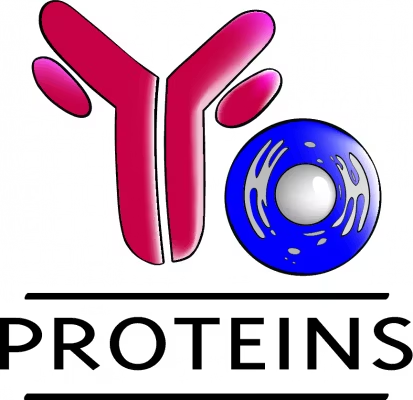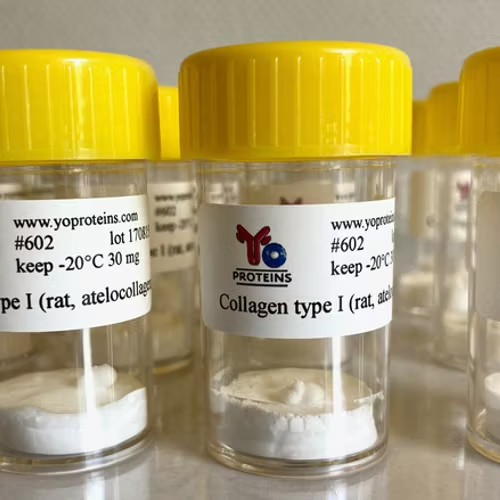288 Collagen type I (human) 0.1 mg
0 EUR
249 EUR
Human collagen type I protein purified from human placenta
Source
Human placenta. Negative for HBsAg, HCV, HIV1 and HIV2
Purity
Human collagen type I at least 90%, human collagen type III below 10%. Other human collagens and non-collagen proteins below 1%. Purity is controlled by SDS-PAGE and by ELISA with anti-collagen type-specific antibodies
Format
Lyophilized
Purification
Partial pepsin digestion in acidic conditions, differential salt precipitation and DEAE ion-exchange chromatography
Applications
Human collagen type I standard e.g. for ELISA and dot blotting (3, 4, 5, 6)
Antigen for antibody production
Coating material for cell culture studies (7)
Glycation of collagen type I, coating at 10 ug/cm2 and adhesion of pancreatic islet-derived mesenchymal stem cells (PI-MSCs) (7)
Cell attachment assay (9)
The zona pellucida of a blastocyst-stage human embryo was plated on 10 ng/ml collagen type I (10)
Collagen type I rescue experiments (11)
Application notes: Cell attachment assay
HeLa cell are detached by non-enzymatic dissociation buffer and reseeded onto 96-well polystyrene plate coated with 40 ug/ml collagen I (CC050, Millipore) for 30 mins. After the non-adherent cells were washed away by DMEM media, the remaining attached cells were quantified by crystal violet-based spectrophotometric method.
Use 0.1 M acetic acid, pH 3.0
Storage
Shipping at ambient temperature. Storage 2 years at -20°C or lower
Citations
1. Brokopp CE, Schoenauer R, Richards P, Bauer S, Lohmann C, Emmert MY, Weber B, Winnik S, Aikawa E, Graves K, Genoni M, Vogt P, Löscher TF, Renner C, Hoerstrup SP, Matter CM. (2011) Fibroblast activation protein is induced by inflammation and degrades type I collagen in thin-cap fibroatheromata. Eur Heart J. 2011 Nov;32(21):2713-22
2. Capossela S, Schläfli P, Bertolo A, Janner T, Stadler BM, Pätzel T, Baur M, Stoyanov JV. Degenerated human intervertebral discs contain autoantibodies against extracellular matrix proteins. Eur Cell Mater. 2014 Apr 4;27:251-63
3. Philips N, Chalensouk-Khaosaat J and Gonzalez S (2015) Stimulation of the Fibrillar Collagen and Heat Shock Proteins by Nicotinamide or Its Derivatives in Non-Irradiated or UVA Radiated Fibroblasts, and Direct Anti-Oxidant Activity of Nicotinamide Derivatives. Cosmetics 2015, 2(2), 146-161; doi:10.3390/cosmetics2020146
4. Kuzan A, Chwilkowska A, Maksymowicz K, Szydelko-Bronowicka A, Stach K, Pezowicz C, Gamian A (2018) Advanced glycation end products as a source of artifacts in immunoenzymatic methods. Glycoconjugate Journal 35(1) DOI: 10.1007/s10719-017-9805-4
5. Philips N, Samuel P, Parakandi H, Gopal S, Siomyk H, Ministro A, Thompson T, Borkow G (2012) Beneficial Regulation of Fibrillar Collagens, Heat Shock Protein-47, Elastin Fiber Components, Transforming Growth Factor 1, Vascular Endothelial Growth Factor and Oxidative Stress Effects by Copper in Dermal Fibroblasts. Connective Tissue Research 1-7
6. Mogami H, Keller PW, Shi H, Word RA (2014) Effect of Thrombin on Human Amnion Mesenchymal Cells, Mouse Fetal Membranes, and Preterm Birth. THE JOURNAL OF BIOLOGICAL CHEMISTRY VOL. 289, NO. 19, pp. 13295-13307
7. Duruksu G and Aciksari A (2018) Guiding the Differentiation Direction of Pancreatic Islet-Derived Stem Cells by Glycated Collagen. Stem Cells Int. Jul 3. doi: [10.1155/2018/6143081]
8. Colin D Paul, Alex Hruska, Jack R Staunton, Hannah A Burr, Jiyun Kim, Nancy Jiang, Kandice Tanner (2017) Decoupling cellular response to topography and stiffness in three dimensions. bioRxiv, 232066
9. Rui Y-N, Xu Z, Fang X, Menezes MR, Balzeau J, Niu A, Hagan JP, Kim DH (2017) The Intracranial Aneurysm Gene THSD1 Connects Endosome Dynamics to Nascent Focal Adhesion Assembly. Cell Physiol Biochem 2017;43:2200-2211
10. Dumevska B, Chami O, McKernan R, Divya Goel Uli Schmidt (2016) Derivation of Genea052 human embryonic stem cell line. Stem Cell Research. Volume 16, Issue 2, March 2016, Pages 327-330
11. Feng Y-X, Jin DX, Sokol ES, Reinhardt F, Miller DH, Gupta PB (2017) Cancer-Specific PERK Signaling Drives Invasion and Metastasis through CREB3L1. Nature Communications 8, 1 (October 2017): 1079


















